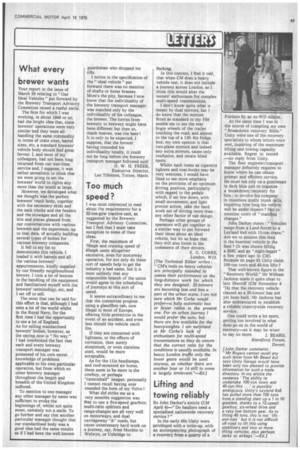Too much speed ?
Page 51

If you've noticed an error in this article please click here to report it so we can fix it.
I was most interested to read about the requirements for a 32-ton-gcw tractive unit, as suggested by the Brewery Transport Advisory Committee, but I feel that I must take exception to some of their ideas.
First, the maximum of 70mph and cruising speed of 65mph seem altogether excessive, even for motorway operation, for not only do these 3ort of speeds help to get the industry a bad name, but it is most unlikely that any responsible branch of the union would agree to the scheduling of journeys at this sort of speed.
It seems extraordinary to me that the committee propose using a glassfibre cab, now illegal in most of Europe, offering little protection in the event of an accident, and even less should the vehicle catch fire.
If they are concerned with lightness, or the effects of corrosion, then surely aluminium, or even stainless steel, would be more acceptable.
As for the Itin headlamps, and roof-mounted air horns, these seem to be more in the cowboy, or perhaps "cannonball" images; personally I cannot recall having ever sounded the horn of my Volvo !
What did strike me as a very sensible suggestion was that to use a five-speed gearbox; multi-ratio splitters and range-changes are all very well on motorways, and dual carriageway "A" roads, but cause unnecessary hard work on a journey, say, from Morden to Welwyn, or Uxbridge to Barking.
In this context, I find it odd, that when CM does a heavy vehicle test, it does not include a journey across London, as I think this would alter the testers' enthusiasm for complex multi-speed transmissions.
I don't know quite what is meant by dual mirrors, but 1 do know that the mirrors fitted as standard to my F88 enable me to see the rear bogie wheels of the trailer touching the road, and almost to the top of a 131t Sin fridge box; my own opinion is that two-plane mirrors and indeed any extra mirrors, cause only confusion, and create blind spots.
Whilst such items as cigarette lighters and coat-hooks may be very welcome, I would have liked to see more emphasis on the provision of an optimum driving position, particularly with regard to the pedals which, if set low down, with small movements, and light precise action, take the hard work out of driving more than any other factor of cab design.
Perhaps other groups of operators will get together in a similar way to put forward their ideas about an ideal vehicle, but let us hope that they will also listen to the comments of their drivers.
E. G. CORKE,
London, W13. IThe Technical Editor writes : " CM's tests on heavy vehicles are principally intended to assess their performance on the long-distance work for which they are designed : 32-tonners are becoming less and less a part of the urban scene. I am not sure which Mr Corke would prefer—a fully automatic box or fewer ratios in the present one. For an urban journey I would prefer the auto, but there are few available for the heavyweights. I am surprised at Mr Corke's lack of enthusiasm for multi-speed transmissions as they do ensure that the correct ratio for the conditions is usually available. In heavy London traffic only the lower gears would be used anyway, so whether there are another four or 14 still to come is largely irrelevant."—Edj








































































































































